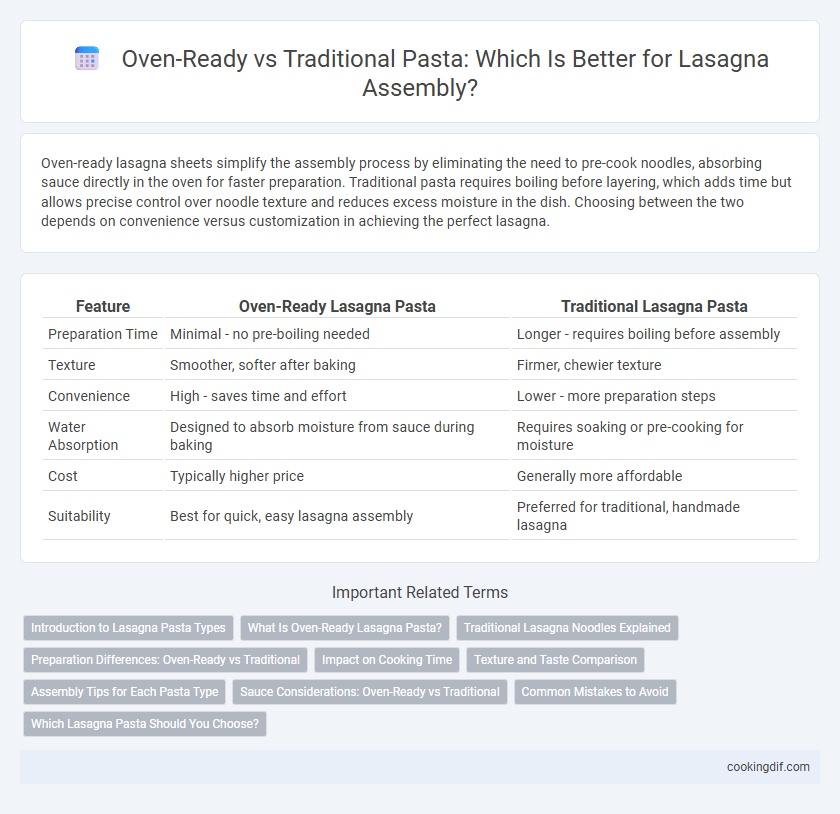Oven-ready lasagna sheets simplify the assembly process by eliminating the need to pre-cook noodles, absorbing sauce directly in the oven for faster preparation. Traditional pasta requires boiling before layering, which adds time but allows precise control over noodle texture and reduces excess moisture in the dish. Choosing between the two depends on convenience versus customization in achieving the perfect lasagna.
Table of Comparison
| Feature | Oven-Ready Lasagna Pasta | Traditional Lasagna Pasta |
|---|---|---|
| Preparation Time | Minimal - no pre-boiling needed | Longer - requires boiling before assembly |
| Texture | Smoother, softer after baking | Firmer, chewier texture |
| Convenience | High - saves time and effort | Lower - more preparation steps |
| Water Absorption | Designed to absorb moisture from sauce during baking | Requires soaking or pre-cooking for moisture |
| Cost | Typically higher price | Generally more affordable |
| Suitability | Best for quick, easy lasagna assembly | Preferred for traditional, handmade lasagna |
Introduction to Lasagna Pasta Types
Oven-ready lasagna pasta sheets are designed for convenience, allowing direct layering without pre-boiling, which reduces preparation time and simplifies assembly. Traditional pasta sheets require boiling before use, offering a tender texture and better absorption of sauces during baking. Selecting the right type of lasagna pasta depends on balancing ease of preparation with desired texture and flavor integration in the final dish.
What Is Oven-Ready Lasagna Pasta?
Oven-ready lasagna pasta consists of thin, precooked sheets designed to eliminate the need for boiling before assembly, saving preparation time and simplifying the cooking process. This type of pasta absorbs moisture directly from sauces during baking, ensuring even texture without becoming mushy when used with adequately saucy recipes. Traditional lasagna pasta requires pre-cooking to soften the noodles before layering, which adds an extra step but can result in more control over texture and doneness in the final dish.
Traditional Lasagna Noodles Explained
Traditional lasagna noodles require pre-cooking before assembly, allowing for better absorption of sauces and enhanced texture in the final dish. These noodles, made from durum wheat semolina, soften evenly during boiling, ensuring that layers meld seamlessly without becoming soggy. Using traditional pasta offers greater control over the dish's moisture balance and overall flavor development compared to oven-ready alternatives.
Preparation Differences: Oven-Ready vs Traditional
Oven-ready lasagna noodles require no boiling and can be layered directly with sauce, saving preparation time and reducing kitchen cleanup. Traditional pasta sheets must be boiled until al dente before assembly, ensuring optimal texture and preventing graininess in the final dish. Choosing oven-ready pasta simplifies the cooking process, while traditional noodles offer greater control over firmness and moisture absorption.
Impact on Cooking Time
Oven-ready lasagna noodles significantly reduce cooking time by eliminating the need to pre-boil, allowing direct layering with sauce and cheese. Traditional pasta requires boiling before assembly, extending preparation and overall bake time. Choosing oven-ready noodles streamlines the cooking process while maintaining texture and flavor in the final dish.
Texture and Taste Comparison
Oven-ready lasagna noodles offer a smoother, slightly firmer texture due to their thinner profile and pre-treatment, allowing for quicker absorption of sauce and even cooking. Traditional lasagna pasta tends to have a chewier bite and richer wheat flavor because it requires pre-cooking, which helps develop a more pronounced al dente texture. Taste-wise, oven-ready noodles blend seamlessly with layers, enhancing a cohesive flavor, while traditional noodles provide a more distinct pasta presence that can elevate the overall complexity of the dish.
Assembly Tips for Each Pasta Type
Oven-ready lasagna noodles require no pre-boiling and are easier to layer, ideal for quick assembly as they absorb sauce while baking. Traditional pasta needs pre-cooking to achieve the right texture, ensuring the noodles don't dry out and preventing a mushy dish. For best results, spread an even layer of sauce before adding oven-ready noodles, while traditional pasta benefits from slightly undercooked sheets and moisture-rich fillings.
Sauce Considerations: Oven-Ready vs Traditional
Oven-ready lasagna noodles require less sauce absorption because they soften during baking, allowing for a thicker, more concentrated sauce without risk of dryness. Traditional pasta needs more sauce or additional liquid to fully hydrate before baking, preventing undercooked noodles and ensuring even texture. Choosing between the two impacts the sauce consistency and layering technique crucial for optimal lasagna assembly.
Common Mistakes to Avoid
Using oven-ready lasagna noodles can cause uneven cooking if not enough sauce is applied, leading to dry or chewy layers, while traditional pasta requires pre-cooking to avoid undercooked textures. A common mistake with traditional noodles is overcooking, which results in mushy lasagna, whereas insufficient sauce with oven-ready noodles prevents proper hydration, affecting overall texture. Ensuring even sauce distribution and following package instructions for noodle preparation can prevent these common errors and produce a perfectly layered dish.
Which Lasagna Pasta Should You Choose?
Oven-ready lasagna pasta offers convenience by eliminating the need to boil sheets before assembly, saving time and reducing mess, while traditional pasta requires pre-cooking to achieve the ideal texture. Choosing oven-ready pasta is ideal for quicker preparation and a firmer, slightly al dente finish, whereas traditional pasta allows for greater absorption of sauces, resulting in a more tender and cohesive layering. Factors such as recipe complexity, preferred texture, and cooking time should guide whether to use oven-ready or traditional lasagna pasta.
Oven-ready vs Traditional pasta for assembly Infographic

 cookingdif.com
cookingdif.com